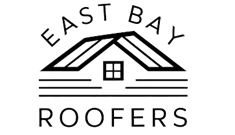To guarantee safety on roofing projects, follow OSHA Roofing Safety Standards. Regularly inspect equipment like fall protection gear and ladders. Make sure safety harnesses and guardrails are in place to prevent falls. Stay updated on OSHA regulations for hazard communication. Proper maintenance of tools and equipment is vital for a secure work environment. Establish clear guidelines for roof edge safety and conduct regular safety audits. Understanding and implementing these standards are essential, but there's more valuable information to explore for a secure working environment.
Overview of OSHA Roofing Standards
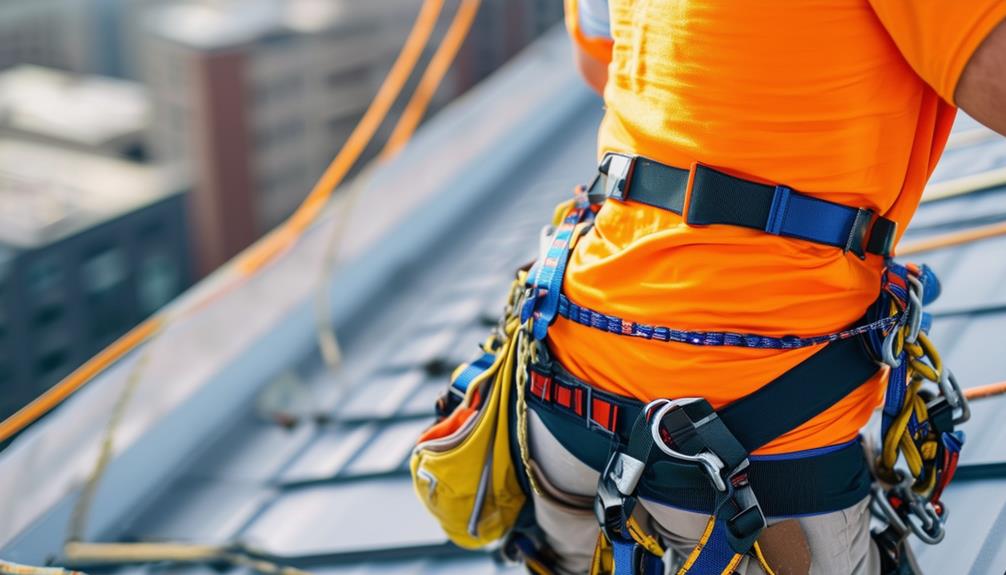
Familiarize yourself with the OSHA roofing standards to guarantee compliance and prioritize safety on your roofing projects. In the roofing industry, following OSHA regulations is important to assure the well-being of workers and prevent accidents. When it comes to roofing equipment, it is crucial to adhere to the safety guidelines set forth by OSHA to maintain a secure working environment. Make sure to regularly inspect and maintain all roofing equipment to ensure it is in proper working condition and meets safety standards.
Understanding OSHA regulations specific to the roofing industry is significant for all involved in roofing projects. These regulations cover a wide range of safety aspects, including fall protection, ladder safety, and hazard communication. By being aware of and implementing these regulations, you can create a safer work environment for everyone involved in the roofing project. Stay updated on any changes or updates to OSHA standards to guarantee ongoing compliance and enhance safety measures on your worksites.
Roofing Safety Training Requirements
When it comes to roofing safety training requirements, you should be aware of the course duration and the renewal period for certifications. Understanding how long the training will take and when you need to renew your certification are essential aspects to keep in mind for maintaining safety standards on the job. Keep these points in mind as you navigate through the training requirements in the roofing industry.
Training Course Duration
Finishing a thorough roofing safety training course usually requires participants to dedicate a minimum of 10 hours to complete the necessary modules and assessments. The training effectiveness greatly depends on the quality of the curriculum provided. Regular updates to the curriculum guarantee that participants are equipped with the most current safety practices and regulations.
When considering training options, both online and in-person courses have their advantages. Online training offers flexibility, allowing participants to complete modules at their own pace and convenience. It is also often more cost-effective and can reach a wider audience. On the other hand, in-person training provides a more hands-on and interactive learning experience. Participants can directly interact with instructors, ask questions, and practice safety techniques in real-time. The choice between online and in-person training ultimately depends on individual preferences, learning styles, and logistical considerations. Whichever method you choose, ensuring the training is thorough and up-to-date is essential for maintaining a safe working environment.
Certification Renewal Period
Participants must complete a roofing safety training certification renewal every two years to guarantee compliance with current safety standards and regulations. This renewal period secures that workers stay up-to-date with the latest safety practices and OSHA requirements. To maintain certification, individuals are required to undergo a refresher course that covers key aspects of the safety program, such as fall protection, hazard communication, and equipment operation. By participating in this renewal process, workers demonstrate their commitment to safety in the roofing industry and reduce the risk of accidents or injuries.
During the certification renewal period, participants will review essential safety guidelines, procedures, and protocols to reinforce their knowledge and skills. The training will also address any new developments in safety regulations or technologies that may have emerged since the initial certification. By staying informed and regularly updating their safety training, workers contribute to a safer work environment for themselves and their colleagues while meeting OSHA requirements.
Fall Protection Guidelines for Roofing
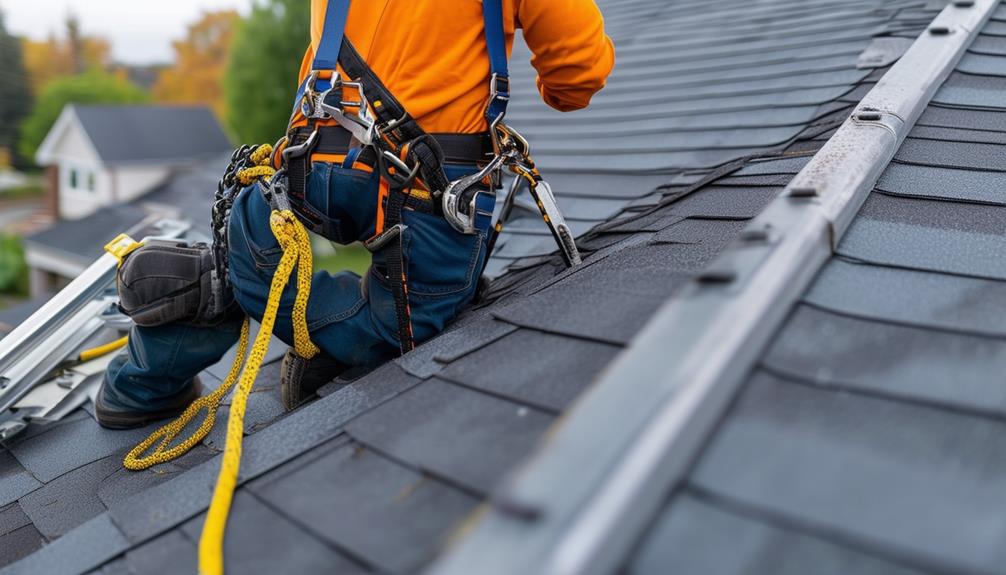
When working on roofs, it's essential to have the right fall protection equipment to prevent accidents. This includes harnesses, lanyards, and anchors that meet safety standards. Additionally, ensuring roof edge safety measures are in place is vital to protect workers from falls.
Fall Protection Equipment
An essential aspect of maintaining roofing safety standards involves utilizing proper fall protection equipment according to specific guidelines tailored for roofing work. Safety harnesses are vital when working at heights to prevent falls. Make sure that the harness fits properly and is connected to a secure anchor point. Guardrails provide a physical barrier along the roof edges, offering protection from accidental falls. Regularly inspect guardrails to ensure they are stable and intact. Ladder systems should be securely anchored and have slip-resistant rungs to prevent accidents during ascent and descent. It is essential to follow OSHA regulations when selecting, inspecting, and using fall protection equipment. Regular training on the proper use of safety harnesses, guardrails, and ladder systems is essential for all roofing workers to minimize the risk of falls and ensure a safe working environment. Remember, investing in high-quality fall protection equipment is an investment in the safety and well-being of everyone on the job site.
Roof Edge Safety
Make sure to establish clear fall protection guidelines for roof edge safety to safeguard workers during roofing tasks. Roof edge awareness is important to prevent falls and accidents. Safety protocols should include regular inspections of the roof edge barriers to make sure they are secure and in good condition. It is essential to provide proper training to workers on how to identify potential hazards near the roof edge and how to safely navigate around them.
Roof edge barriers, such as guardrails and safety nets, play a significant role in worker protection. These barriers should be installed along all exposed edges of the roof to create a physical barrier that prevents accidental falls. Additionally, workers should always wear personal fall protection equipment, such as harnesses and lanyards, when working near the roof edge.
Equipment Inspection and Maintenance
Regularly inspecting and maintaining your roofing safety equipment is essential for guaranteeing a safe work environment. When it comes to equipment inspection and maintenance, there are key aspects to keep in mind: Regularly inspecting and maintaining your roofing safety equipment is essential for guaranteeing a safe work environment. When it comes to equipment inspection and maintenance, there are key aspects to keep in mind: Make sure all safety gear for roofing work, such as harnesses, lanyards, and anchor points, is free from damage and meets current safety standards. Additionally, store the equipment in a clean, dry place to prevent wear and tear, and replace any compromised items immediately to avoid unnecessary risks. Frequent checks help ensure your gear remains reliable when it’s needed most.
- Safety Harnesses: Check for any signs of wear and tear on the safety harness straps, buckles, and D-rings. Ensure that all connections are secure and in good condition to provide adequate fall protection.
- Tool Maintenance: Inspect all tools regularly to verify they are in proper working condition. Pay close attention to the condition of ladders, scaffolding, and any other equipment used for roofing tasks. Repair or replace any damaged tools promptly to prevent accidents.
- Anchorage Points: Verify the integrity of anchorage points before each use. Make sure they are securely attached and capable of supporting the intended load to prevent falls.
- Emergency Equipment: Inspect emergency equipment such as first aid kits and rescue devices to guarantee they are fully stocked, accessible, and functional in case of an emergency. Regular maintenance of these items is vital for a quick response to any incidents that may occur on the job.
Hazard Communication in Roofing Work
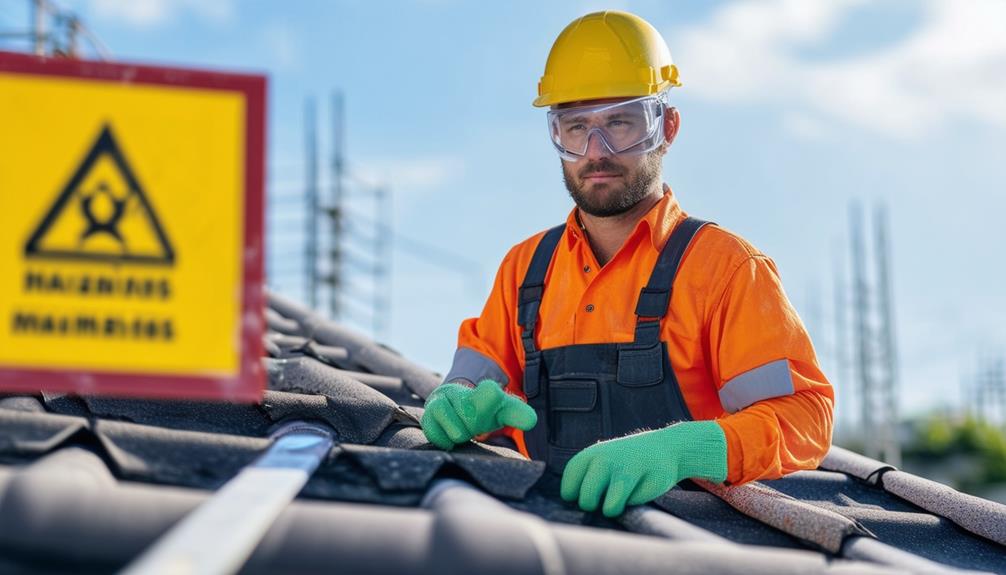
Effective hazard communication in roofing work involves accurately identifying, documenting, and communicating potential risks to all individuals involved in the project. Safety signs play an important role in conveying important information about hazards present on the job site. It is essential to make sure that all safety signs are prominently displayed and easily visible to workers. Additionally, managing Material Safety Data Sheets (MSDS) is critical for providing detailed information about the chemicals and materials used in roofing work. Proper MSDS management includes keeping the sheets up to date, easily accessible, and ensuring that all workers are trained on how to interpret the information provided. By effectively utilizing safety signs and maintaining thorough MSDS management, you can enhance hazard communication in roofing work, ultimately promoting a safer work environment for everyone involved. Remember, clear communication and easy access to hazard information are key components of a successful safety program in roofing.
Recordkeeping and Reporting Obligations
Keeping accurate records and fulfilling reporting obligations are essential aspects of maintaining compliance with roofing safety standards. When it comes to recordkeeping and reporting in the roofing industry, it is vital to pay close attention to detail and follow specific guidelines to guarantee a safe working environment. Here are some key points to bear in mind:
- Incident Investigation: Promptly investigate any workplace incidents, injuries, or near misses to determine the root causes and implement corrective actions to prevent future occurrences.
- Safety Audits: Conduct regular safety audits to assess the effectiveness of your safety programs, identify potential hazards, and ensure that all safety protocols are being adhered to.
- Record Retention: Maintain detailed records of safety training, inspections, incident reports, and safety audits for a specified period as required by OSHA regulations.
- Reporting Obligations: Report any serious injuries, fatalities, or work-related illnesses to OSHA as per the established guidelines to comply with reporting requirements and promote transparency in workplace safety practices.
OSHA Inspections and Enforcement Actions
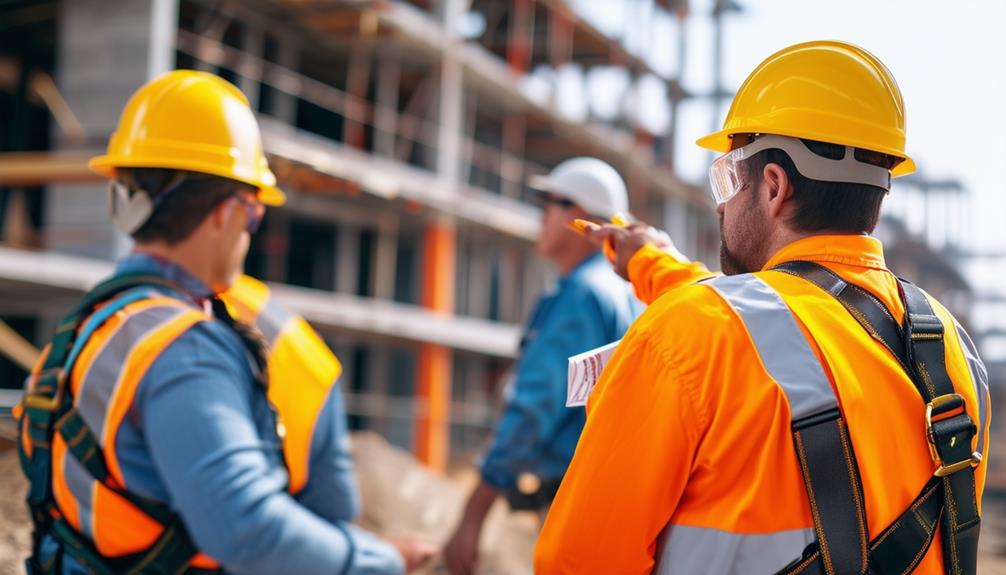
When it comes to ensuring compliance with roofing safety standards, being prepared for OSHA inspections and potential enforcement actions is a vital aspect of maintaining a safe working environment. The OSHA inspection process involves a thorough examination of your roofing worksite to assess compliance with safety regulations. Inspectors may review safety documentation, observe work practices, and interview employees to ensure adherence to OSHA standards.
Failure to comply with OSHA regulations during inspections can lead to enforcement consequences. These consequences may include citations, fines, or even work stoppages until safety violations are rectified. It is important to address any identified safety issues promptly to avoid escalating enforcement actions.
To prepare for OSHA inspections, make sure that all safety documentation is up to date, conduct regular safety training for employees, and perform routine safety audits of your roofing worksite. By proactively addressing safety concerns and being prepared for OSHA inspections, you can create a safer working environment for your roofing team.
Frequently Asked Questions
Can Drones Be Used for Roof Inspections Under OSHA Standards?
Yes, drones can be utilized for roof inspections, following safety guidelines. They offer a safe and efficient way to assess roofs without risking human lives. When using drones for inspections, make sure to comply with OSHA regulations to guarantee the safety of workers and the public. By adhering to the proper protocols, drone inspections can enhance overall safety and accuracy in roof assessments, providing valuable insights while minimizing risks.
Are There Specific Safety Guidelines for Solar Panel Installation on Roofs?
When dealing with solar panel safety guidelines, it's vital to adhere to specific regulations. Installers must follow best practices and guidelines for safe installation. Regulations cover aspects like proper anchoring methods, electrical safety protocols, and fall protection measures. Understanding these requirements guarantees a secure installation process and minimizes risks associated with solar panel installations on roofs. Always prioritize safety and compliance with these essential guidelines.
What Are the Requirements for Working in Extreme Weather Conditions on Roofs?
When working on roofs in extreme weather conditions, it's important to prioritize your safety. Make sure you have adequate heat protection to prevent heat-related illnesses. In cold conditions, be mindful of cold exposure risks and dress in layers. Wind safety is essential to avoid accidents, and rain precautions should be taken to prevent slips and falls. Always stay vigilant and follow proper safety protocols to guarantee your well-being while working in such challenging environments.
How Often Should Roofing Equipment Be Replaced According to Osha?
When it comes to roofing equipment, safety regulations are vital. To guarantee compliance standards, equipment lifespan and maintenance schedules need to be strictly followed. According to OSHA guidelines, roofing equipment should be replaced based on the manufacturer's recommendations, which typically range from 5 to 15 years depending on the type of equipment. Regular inspections and adherence to replacement timelines are essential to maintain a safe working environment and prevent accidents.
What Safety Measures Should Be Taken When Working on Green Roofs?
When working on green roofs, it is crucial to be mindful of the unique hazards they present. Safety precautions like wearing proper footwear with good traction, using fall protection gear, and being cautious of potential slippery surfaces are key. Additionally, make sure you have adequate training and supervision when working on green roofs to minimize the risks associated with this specific type of roofing environment.
Conclusion
So, now that you're well-versed in OSHA roofing safety standards, you can rest easy knowing that your safety is a top priority. Just remember, accidents happen when you least expect them, so always be on your guard! Stay safe out there, and don't forget your hard hat – it's not just a fashion statement, it's a lifesaver. Happy roofing!
